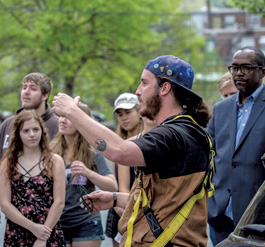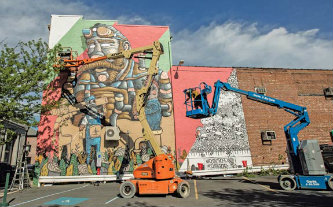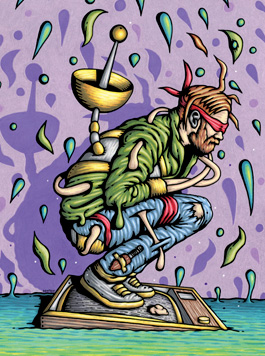A Mural Rises
Video: Stephanie Veto
Riding a mechanical lift up three stories, in a lot that’s a short walk from Lehigh’s main campus, Denton Burrows ’11 gets to work in creating a 34-foot-high mural that pays homage to Bethlehem’s steel-making history while giving a nod to the physical changes that reflect the section’s revitalization.
Onlookers gather as Burrows—spray paint can in hand—helps give shape to the mural that, over five days in April, transforms the stucco wall of a Third Street building. The commission is part of the SouthSide Arts & Music Festival, and Burrows and fellow artists who are part of the unique Dripped on the Road traveling artist residency program are a main attraction.
Traffic eases past, and the sounds of nearby construction add to the street’s vibrancy. Burrows pulls back the lift to get a better view of his work, then resumes painting, forming the steelworker’s face. Other artists work below him and to the right, rolling strips of color onto the wall and adding other characters and pop-art features.
Burrows, co-founder of the art production company Dripped On Productions, understands the draw of street art. He has created countless murals as visual social commentary.
“Public art, in general, is very powerful because it’s not locked in a room in a gallery that some people can’t access or can’t afford,” says Burrows, who graduated with a degree in fine arts. “It’s for everybody, no matter how old or how much money you have or what race you are, and it has a lot of power to brighten up and inspire neighborhoods.”
Burrows was named one of the top street artists to watch by Network A and Paper Magazine, and he was featured in Creative Quarterly’s Top 100 Artists, Designers and Photographers of 2014. He won the National Can Art competition for Pabst Blue Ribbon Beer, with his winning design appearing on 35 million cans. He’s also assistant curator and project manager of the Centre-Fuge Public Art Project in New York City.
Burrows first took to the road with Dripped on the Road in 2016. Traveling in two RVs over 40 days, the artists created murals and gave talks in East Coast communities. Their first stop was the Banana Factory in Bethlehem, where they created a 10-foot-by-9-foot banner that now hangs outside the arts center’s doors. The steelworkers mural capped a second, monthlong traveling residency.
“There’s a freedom to this life that’s intoxicating,” he says about the traveling artistry work. ”I don’t think about the day that it ends.”
Though Burrows has been doodling since he was a kid—and getting in trouble for drawing in school—he initially considered a degree in psychology or anthropology at Lehigh. Viewing art as more of a hobby, he took an elective Drawing I class taught by Berrisford Boothe, associate professor of art. The pairing of student and teacher proved serendipitous.
“I actually wasn’t doing that well, because it wasn’t the kind of things I love to draw,” Burrows says. “At a review at the end of the semester, I had to meet one-on-one with Berris, and I brought my still lifes, which I wasn’t that proud of. But I also brought my personal sketchbook that I really had never shown anybody, and he was quite enamored by it. And then over many, many conversations with him and meetings, we started to explore the possibility that this might be something to pursue, if I wanted to.”
Burrows has always been fascinated with the study of people and with why things happen, and that’s reflected in his art. By his own description, his work is complicated and connected and has a surreal quality. Each piece, he says, however, is an open-ended narrative. “It’s rarely so obvious what it’s about that somebody guesses it right off the bat. It’s just kind of supposed to be an inviting, colorful, visual puzzle for people to explore and get what they want out of it.”
Burrows says he doesn’t start a piece knowing exactly what it will be about. (The exception was the Bethlehem mural.) “I just kind of say, ‘Oh, I have enough stuff here that I can start.’ But I never plan it out fully. I decide how big it is, and I just let it organically grow as I, myself, sort of organically contemplate the topics or the influences at that moment.”
With each mural, Burrows says, community members eventually show up. They are initially skeptical, he says, then express thanks that the artists brightened a wall and gave them something to look at. “It just makes people happy. That’s how humans work,” he says. “I’m happy to be a part of that.”
Posted on:




